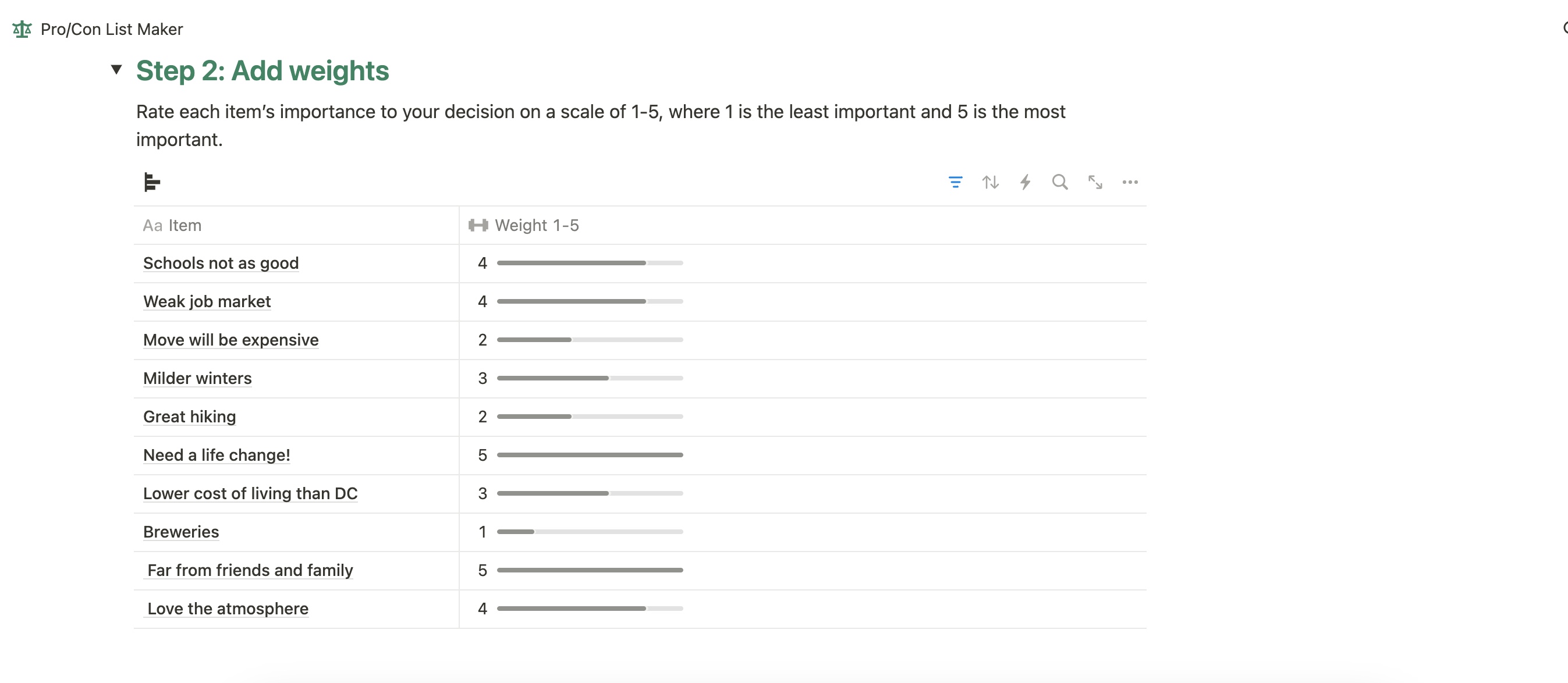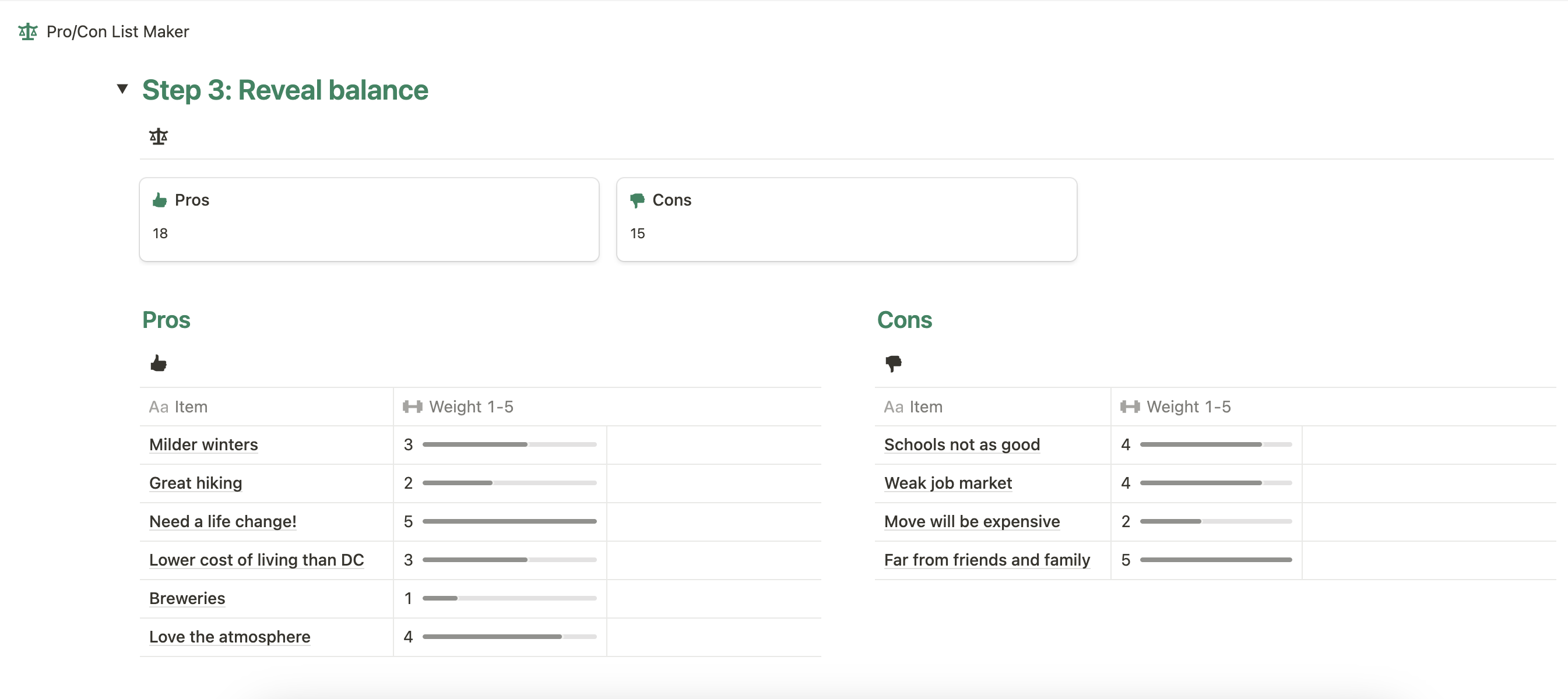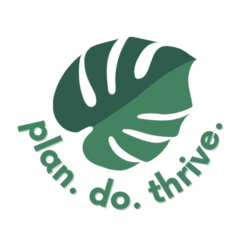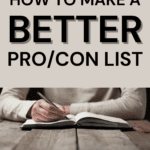Did you know that the first pro/con list template was created by Benjamin Franklin? A friend wrote to him asking for advice about whether to take a job offer. In a letter back, Franklin said he couldn’t tell his friend what to decide, but he could tell him how. He suggested that his friend list the positive and negative outcomes of taking the job, add weights, and make a decision.
What Franklin called “prudential algebra”, also known as a pro/con list, is still used by job seekers and millions of other decision-makers today. However, there are some challenges in this familiar method, found in unconscious biases that you may not realize are affecting your thought processes, as well as the weight that factors are given.
Below, we’ll go through ways to improve your basic decision table to address these problems, and share a pro/con list template you can use to make better decisions. As we like to say on this site, make a plan, do what you planned, and live your best life and thrive.
Why use a pro/con list
Any decision-making method that forces you to slow down and consider all impacting factors is beneficial. The first tool many people turn to is the pros and cons list, because it’s familiar. I’d argue that its simplicity and elegance also help you avoid getting bogged down in finicky methods and get straight to the heart of the matter: deciding.
Pro/con lists are great for:
- “Whether or not” decisions, such as whether to accept a job offer in another city, or whether to add ballet to your first-grader’s extracurricular schedule
- Decisions you’re making with a partner, because you can write down and consider both of your perspectives
- Tracking your decision-making process, so you can return to it down the road – either when evaluating the consequences after you’ve made the decision, or when making a similar decision in the future
This simple model can help you:
- Visualize your options in a chart, which helps you process it as a whole
- Bring a level of objectivity to a decision (although as we’ll discuss below, be wary of the feeling of objectivity)
- Picture the consequences of your choice by imagining both options
- Reduce stress and anxiety by giving yourself control over your decision
- Give yourself emotional distance. When you make your list, you frame the problem as external to your mind, which can help separate your emotions from the process.
How to make a pro/con list – and improve the basic format
There are some pitfalls to avoid when using the pro/con list model. Consider the “framing effect” – the unconscious positive or negative bias you already have toward the decision, which can cause bias in your evaluation, through the factors you consider and the outcomes you imagine. Though the method feels objective, it is subjective. The only items that make it to your list are the ones that you imagine and write down.
So, ensure that you take the time to open up your mind. Ask yourself questions like:
- How would making this decision affect others, such as your spouse or coworkers?
- What sacrifices would you be making with this decision?
- How would making this decision help you reach your long-term goals?
- Are there any risks that come with this decision?
- How will you feel in a year or five years if you make this decision? Or if you decide against it?
- If this decision were a friend’s instead of yours and she asked for advice, what would you tell her?
Consider whether you can ask someone else to assess your pro/con list and add any factors you may have missed.
It’s also easy to fall into the trap of thinking that each item on the list should be treated equally. If you have three pros and five cons, well, con wins, right? Maybe not if one of the pros is “I will earn twice my current salary” versus cons like “the commute will be ten minutes longer.” Of course, the relative weight is up to you to decide.
Benjamin Franklin’s original model actually addressed this issue, though it’s often lost in back-of-the-napkin iterations. He advised his friend to “estimate respective weights” of each item, and “find two on each side that seem equal and strike them out”. You can do the same. Decide on a scale, for example, a score between one and five, and assign a weight to each pro and con item.
Lastly, consider adding time. Let your decision marinate for a few days, if you’re able. When you’re driving, in the shower, or trying to fall asleep, you will most likely think of another item to add to your list.
Now, let’s get listing.
How to use this online pro and con list maker
To address the biases above and create a simple, trackable, and repeatable pro/con list, I created a Notion pro/con list template that you can use to make decisions. Here’s how it works.
First, create your decision question. It works best to form this as a yes or no question. In this example, the question is “Should I move to Asheville, NC?”
Next, go to Step 1 and list all the pros and cons you can think of. Use the randomly generated prompt for inspiration. You can refresh the page to get a new prompt.

If you have time, let it sit for a few days before the next step. You could also share your Notion page with your partner or a friend to see if they have any suggestions for items to add.
Then, head to Step 2, where you’ll add a weight to each item with a value of 1-5, where 1 is the least important and 5 is the most important factor. By separating this from the pro/con table, you can more easily think about each factor as it compares to the other factors and how important it truly is.

When you’re ready, go to Step 3 to reveal the balance that you’ve weighted your pros and cons.

While this doesn’t make the decision for you, it should help clarify your thoughts and make it easier to decide. You can learn from your emotional reaction to the reveal, as well. Now, go get decision-making!
What upcoming decision is on your plate?




